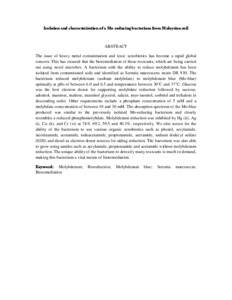Citation
Chee, Hui Sin and Manogaran, Motharasan and Suhaili, Zarizal and Yakasai, Mohd Hafeez and Abdul Rahman, Mohd Fadhil and Shamaan, Nor Aripin and Yasid, Nur Adeela and Othman, Ahmad Razi
(2017)
Isolation and characterisation of a Mo-reducing bacterium from Malaysian soil.
Bioremediation Science and Technology Research, 5 (2).
pp. 17-24.
ISSN 2289-5892
Abstract
The issue of heavy metal contamination and toxic xenobiotics has become a rapid global concern. This has ensured that the bioremediation of these toxicants, which are being carried out using novel microbes. A bacterium with the ability to reduce molybdenum has been isolated from contaminated soils and identified as Serratia marcescens strain DR.Y10. The bacterium reduced molybdenum (sodium molybdate) to molybdenum blue (Mo-blue) optimally at pHs of between 6.0 and 6.5 and temperatures between 30°C and 37°C. Glucose was the best electron donor for supporting molybdate reduction followed by sucrose, adonitol, mannose, maltose, mannitol glycerol, salicin, myo-inositol, sorbitol and trehalose in descending order. Other requirements include a phosphate concentration of 5 mM and a molybdate concentration of between 10 and 30 mM. The absorption spectrum of the Mo-blue produced was similar to the previously isolated Mo-reducing bacterium and closely resembles a reduced phosphomolybdate. Molybdenum reduction was inhibited by Hg (ii), Ag (i), Cu (ii), and Cr (vi) at 78.9, 69.2, 59.5 and 40.1%, respectively. We also screen for the ability of the bacterium to use various organic xenobiotics such as phenol, acrylamide, nicotinamide, acetamide, iodoacetamide, propionamide, acetamide, sodium dodecyl sulfate (SDS) and diesel as electron donor sources for aiding reduction. The bacterium was also able to grow using amides such as acrylamide, propionamide and acetamide without molybdenum reduction. The unique ability of the bacterium to detoxify many toxicants is much in demand, making this bacterium a vital means of bioremediation.
Download File
![[img]](http://psasir.upm.edu.my/64004/1.hassmallThumbnailVersion/Isolation%20and%20characterisation%20of%20a%20Mo-reducing%20bacterium%20from%20Malaysian%20soil.pdf)  Preview |
|
Text (Abstract)
Isolation and characterisation of a Mo-reducing bacterium from Malaysian soil.pdf
Download (36kB)
| Preview
|
|
Additional Metadata
Actions (login required)
 |
View Item |

